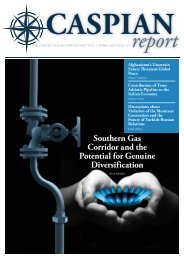Create successful ePaper yourself
Turn your PDF publications into a flip-book with our unique Google optimized e-Paper software.
use continued to grow, albeit fairly<br />
slowly. In fact, average growth rate<br />
was only 0.9% per annum until 2006,<br />
when energy consumption hit a historical<br />
high of 1818.2 million tonnes<br />
of oil equivalent (Mtoe). From 2006,<br />
energy use began to fall, dropping to<br />
1673.4 Mtoe in 2012.<br />
The relative proportions of fuels in<br />
total energy consumption have also<br />
changed significantly. Figure 2 below<br />
plots shares of fuels in total domestic<br />
consumption for the years 1991 and<br />
2010. As can readily be seen from the<br />
figure, the proportion of coal in total<br />
energy use has fallen from 26% to<br />
16%, and the share of oil has fallen<br />
from 38% to 36%. On the other hand,<br />
renewable energy sources have doubled<br />
from 5% to 10%. The proportion<br />
of natural gas also rose significantly,<br />
from 18% to 25%. These figures<br />
suggest that use of cleaner energy<br />
sources has increased during the last<br />
two decades. Such changes can be attributed<br />
to increasing environmental<br />
concerns in EU countries.<br />
As mentioned above, one of the targets<br />
set out in the EU Energy and Climate<br />
Package is to increase energy<br />
efficiency. Therefore, it is expected<br />
that increasing energy efficiency will<br />
cause a significant reduction in total<br />
energy consumption. According<br />
to projections by DG Energy (<strong>2014</strong>),<br />
total energy consumption in the EU-<br />
28 countries will fall on average by<br />
0.38% per annum during the period<br />
from 2010 till 2035. However, as the<br />
improvement in energy efficiency<br />
reaches to its limits, total energy use<br />
will increase thereafter with economic<br />
growth. It is expected that<br />
total energy use in the EU countries<br />
will grow on average by 0.1% per annum<br />
from 2035 to 2050.<br />
The use of renewables will continue<br />
to increase till 2050, and is expected<br />
to reach 24% to total consumption.<br />
On the other hand, the shares of oil<br />
and coal are expected to drop to 31%<br />
and 8%, respectively, by 2050. Natural<br />
gas and nuclear energy will likely<br />
maintain their current proportions.<br />
Historical and projected volumes<br />
and share of fuels for the period until<br />
2050 are presented in Figure 3. Note<br />
that even by 2050, fossil fuels (oil,<br />
gas and coal) will still provide 63%<br />
of the EU’s total energy consumption.<br />
47<br />
CASPIAN REPORT, FALL <strong>2014</strong><br />
Figure 3. Gross domestic energy consumption in the EU.<br />
Source: DG Energy (<strong>2014</strong>). EU Energy, Transport and GHG Emissions, Trends to 2050










